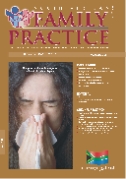Allergic Evaluation and Management of the Atopic Patient
Keywords:
atopy, allergy, allergic,
Abstract
Atopy is defined as an inherited predisposition to produce IgE antibodies in response to natural exposure to minute quantities of environmental allergens, manifesting clinically with atopic diseases. These include food allergy, eczema, asthma, seasonal and persistent rhinitis and urticaria. Not all allergic diseases are atopic in nature. Examples of non-atopic allergic diseases include allergy to drugs (e.g. Penicillin), venoms (e.g. bee sting allergy) and some occupational allergies. The cornerstone of the clinical diagnosis of any atopic disease is a detailed history, followed by specific IgE sensitivity testing. This requires a knowledge of the patients presenting symptoms, his family history and a careful knowledge of the environment in which the patient lives, or works. History taking is time consuming, but always rewarding and the most cost effective part of the clinical evaluation. The history guides the clinician as to the most appropriate clinical or laboratory test and can save the patient and health funder unnecessary expenses since there are hundreds of allergen sensitivities which can be tested. In clinical practice, it is important to distinguish those patients with eczema, rhinitis, asthma and adverse food reactions who are truly allergic or “atopic�? from those who are not. This distinction has a direct bearing on the treatment options for the patient (Figure 1). There are a number of unscientific and unvalidated tests which attempt to identify allergic factors playing a role in the patient’s disease, but many of these are expensive and those which do not specifically determine IgE levels or evidence of mast cell or eosinophil activation are not recommended by Allergologists.
Published
2009-05-25
Section
CPD
By submitting manuscripts to SAFP, authors of original articles are assigning copyright to the South African Academy of Family Physicians. Copyright of review articles are assigned to the Publisher, Medpharm Publications (Pty) Ltd, unless otherwise specified. Authors may use their own work after publication without written permission, provided they acknowledge the original source. Individuals and academic institutions may freely copy and distribute articles published in SAFP for educational and research purposes without obtaining permission.

